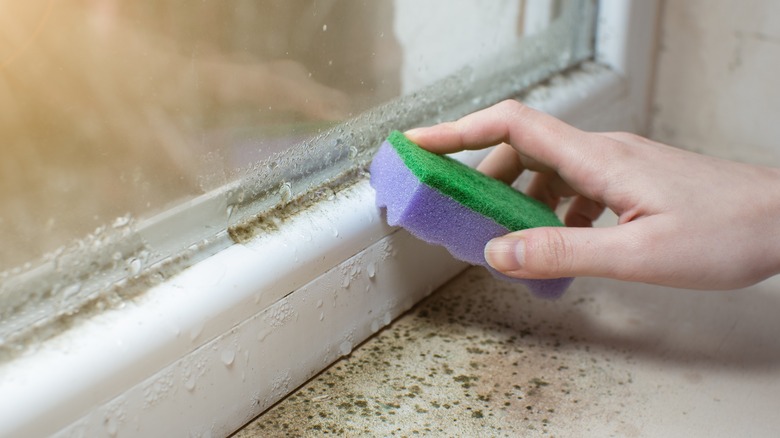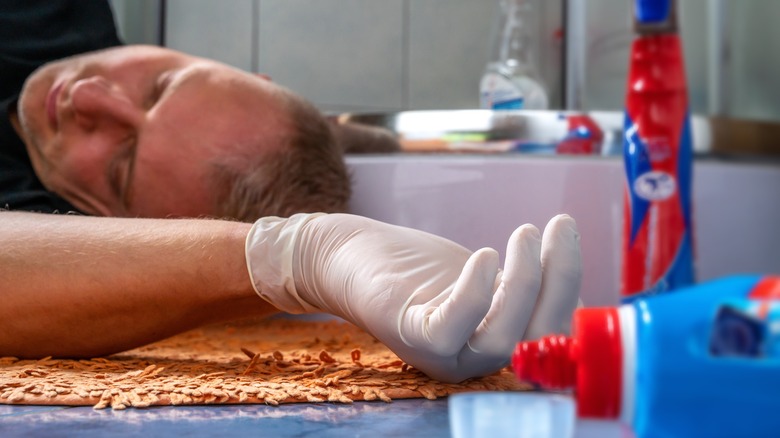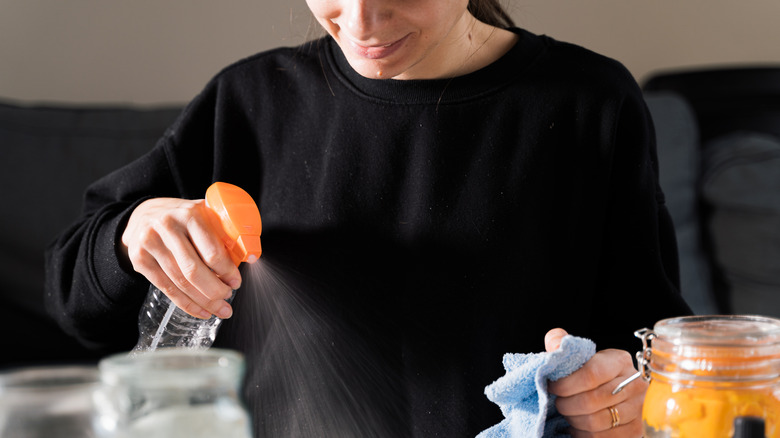Why Cleaning With A Mixture Of Bleach And Mildew Remover Is A Dangerous Idea
In some areas of the U.S., mildew just seems to come with the territory, but it's never welcome, and dealing with it can be an epic pain. Mildew and other forms of mold can destroy fabric and building materials. They can also cause and exacerbate allergies, and in some cases, there's reason to believe there are far worse health implications. Also if you've dealt with mold remediation, you know how frustrating the entire process can be. You get competing advice from experts on how dangerous it is and what to do about it, and bringing in professionals is an unbelievably expensive and fussy process. Somewhere along the way, most of us decide to take a swing at dealing with mold and mildew ourselves, packing a shopping cart full of sprays, foams, brushes, sponges, and — almost inevitably — bleach. And that's where the worst of your troubles can begin because mixing bleach with many other chemicals can produce dangerous substances like chloramine, chlorine gas, and chloroform.
In fact, experts advise you to not combine bleach with any cleaning agents. These experts include the EPA and Clorox, the well-known bleach manufacturer. Clorox suggests that you avoid combining bleach with ammonia, vinegar, or other acids. The CDC says that you should use personal safety equipment even when using bleach by itself, and the EPA recommends against using bleach for mold cleanup.
Bleach mixtures that are dangerous
So what's the big deal? Chloramine is a disinfectant used in the water supply, after all, and isn't chloroform something used during kidnappings in TV dramas? Northwestern University's Office for Research Safety maintains a list of chemicals that are "incompatible" with chlorine bleach, alongside the specific dangers they present. Combined with ammonia, vinegar, or cleaners like phosphoric acid (which is sold by Home Depot and Lowes), bleach can produce chlorine gas, which causes a plethora of health problems including violent cough, chest pain, nausea, vomiting, cyanosis, respiratory tract hemorrhage, tachycardia, and in large concentrations, death. Bleach produces chlorine gas and explosive compounds when combined with various forms of ammonia, such as ammonium hydroxide and quaternary ammonium salts, both of which are found in household cleaners. Combined with bleach, the popular cleaning agent hydrogen peroxide can violently produce oxygen... and explosive results.
Many correctly tout vinegar as a way to get rid of mold. But what happens in some cases is that the vinegar user, unhappy with the mold stains that remain, might bring another cleaner to the mix, and all too often that cleaner contains bleach. The University of Georgia Extension Service has a great resource for removing mold stains from various surfaces, but always take care with any cleaner or chemical since ingredients like bleach and ammonia are not always immediately obvious.
What if you're not sure?
Some time ago, we noticed that a substantial number of people seem to believe that vinegar is a base rather than an acid. The common misconception is complicated by the science underlying it, but the bottom line is that it's enough of an acid that it's dangerous to mix with bleach. This confusion underscores what should become your first priority when deciding when to mix cleaners, and especially when to mix them with bleach: Play it safe.
Sodium hypochlorite, the active ingredient in bleach, is found in a number of cleaning products. Of the first six products returned when searching for mildew stain removers on the Lowes website, five contain bleach and the other contains ammonia. But neither chemical is mentioned in any of the product names, though you might assume bleach is present in Clorox's Tilex products.
The only product we encountered that might not cause a problem with bleach is ammonia-free, bleach-free, VOC-free Concrobium. Its active ingredients — trisodium phosphate (TSP) and sodium carbonate — are often added to chlorine bleach and, in fact, TSP and bleach make a great DIY solution for cleaning exterior mildew. But since sodium carbonate produces carbonic acid when combined with water, Concrobium's manufacturer advises that combining with bleach is unnecessary, and its safety data sheet says it's incompatible with oxidizing agents (which include bleach), it's best to play it safe and keep your perfect streak of never mixing anything with bleach.



